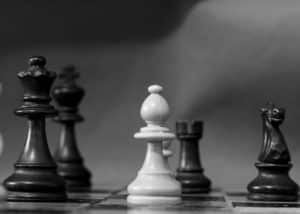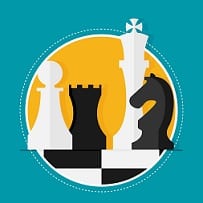
About This Article…
This article includes my notes, additional images and interactive chess positions from my study of Horowitz & Mott-Smith’s book, Point Count Chess.
Source:
Point Count Chess,
Chapter 6. Mobile Pawn Wing
(p72-80)
- A Typical Morphy Attack.
- The Cramped Position.
- Expansion on “General Principles”.
- The Potential Passed Pawn.
- Restraint of a Pawn Wing.
In order to have a Mobile Pawn Wing count as a point, you must already have both of the following:
- Control of the Center;
- Superior Development, on a small sector of the board.
Diagrams 1a & 1b, below, highlight both of these elements, which combine to create Diagram 1c, showing that White possess a Mobile Pawn Wing …
Diagram 1a: White has Center Control
First, in Diagram 1a, above, White’s Advanced Chain in the Center, not only restricts the advancement of Black’s two central pawns, but Black’s pieces also have trouble in getting across to tackle the building pressure, by White, towards Black’s Kingside.
Next comes the Superior Development of White’s pieces, as shown in Diagram 1b, below.
In addition to the center pawns restricting the movement of Black’s pieces, in Black’s own territory, White’s better developed minor pieces – the Knights & Bishops – further restrict the mobility of the Black pieces.
Diagram 1b: White has Superior Development
Take another look at Diagram 1b, and you’ll see that both Black Bishops are Bad, unable to move via the Flanks, due to the position of White’s Bishops, and incapable of penetrating through the Center, due to the position of the center pawns.
All of which leads us to Diagram 1c, below …
Diagram 1c: White, therefore, has a Mobile Pawn Wing
Because Black cannot assemble more Pieces to deal with White’s Pieces (the ones trained on the Black King’s quarter), the White Kingside Pawns are without fear to advance – or, are free to advance towards the Black camp, thus are “Mobile” … and, because these “Pawns” are on the “Wing” (Flank), they’re called a Mobile Pawn Wing.
Just to clarify, further … it doesn’t have to be Mobile Pawns heading towards the adverse King. So long as the “Center Control” and “Superior Development” qualifiers are met, be they on the King- or Queen-side, the Pawns that have free reign to advance are the Mobile Pawn Wing, as can be seen for Black, on the Queenside, in Diagram 2, below:
Diagram 2: Black’s Mobile Pawn Wing on the Queenside of the board.





